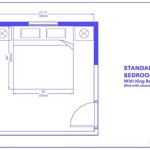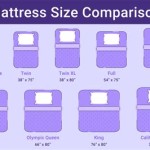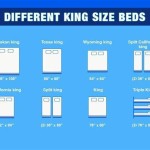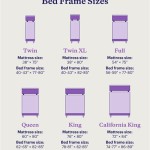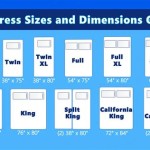Size of King vs. Queen Bed: A Comprehensive Guide
Selecting the appropriate bed size is a critical decision when furnishing a bedroom. The two most popular options, king and queen beds, offer distinct advantages and disadvantages depending on individual requirements and spatial constraints. A careful evaluation of the dimensions, room size, sleeping arrangements, and personal preferences is essential to make an informed choice. This article provides a detailed comparison of king and queen-size beds, exploring their respective sizes, suitability for various needs, and factors to consider during the selection process.
Understanding the Dimensions
The primary differentiating factor between king and queen beds lies in their overall dimensions. These differences in size significantly impact the comfort level and suitability for different users and room configurations.
A standard queen-size bed typically measures 60 inches wide and 80 inches long. This size is a versatile option suitable for single sleepers who desire ample space to stretch out, as well as for couples who prefer a more intimate sleeping arrangement. The queen bed offers a good balance between space efficiency and sleeping comfort, making it a popular choice for guest rooms and smaller master bedrooms.
In contrast, a standard king-size bed measures 76 inches wide and 80 inches long. The increased width provides significantly more personal space for couples, reducing the disturbance caused by movement during sleep. King beds are particularly well-suited for individuals who tend to toss and turn at night, or for couples who share the bed with children or pets. The larger dimensions, however, require a larger bedroom to accommodate the bed comfortably without overcrowding the space.
Beyond the standard king size, there exists a variation known as the California king. This bed measures 72 inches wide and 84 inches long. The California king offers additional length, making it an ideal choice for taller individuals who require extra legroom. However, it is slightly narrower than the standard king, which might be a consideration for couples who prioritize width over length.
The choice between a king and queen bed ultimately depends on the individual's specific needs and priorities. Couples who value ample personal space and minimal sleep disturbance may prefer a king bed, while single sleepers or couples with limited space may find a queen bed more suitable. The California king caters to taller individuals who require extra legroom.
Assessing Room Size and Layout
The size of the bedroom plays a crucial role in determining the appropriate bed size. A bed that is too large can overwhelm a small room, making it feel cramped and claustrophobic. Conversely, a bed that is too small in a large room can appear insignificant and disproportionate.
As a general guideline, a bedroom should have at least two feet of space on all sides of the bed to allow for comfortable movement and access to other furniture. This includes space for opening drawers, walking around the bed, and making the bed.
For a queen-size bed, a bedroom measuring at least 10 feet by 10 feet is generally recommended. This allows for sufficient space around the bed for bedside tables, dressers, and other essential furniture items. Smaller rooms may still accommodate a queen bed, but the furniture arrangement may need to be more carefully planned to maximize the available space.
A king-size bed requires a larger room to accommodate its increased dimensions. A bedroom measuring at least 12 feet by 12 feet is typically recommended. This provides ample space around the bed for comfortable movement and furniture placement. Smaller rooms can accommodate a king bed with careful planning, but may result in a more crowded and less functional space.
It is essential to consider the overall layout of the room when determining the optimal bed size. The placement of doors, windows, and closets can impact the available space and the potential furniture arrangement. Taking accurate measurements of the room and creating a scaled floor plan can help visualize how different bed sizes will fit within the space.
In addition to the bed itself, the size and placement of other furniture items should be considered. Bedside tables, dressers, and chairs should be proportionally sized to the bed and arranged in a way that does not obstruct movement or create a cluttered appearance. A well-balanced and harmonious furniture arrangement contributes to the overall comfort and functionality of the bedroom.
Considering Sleeping Arrangements and Personal Preferences
The choice between a king and queen bed is significantly influenced by the intended sleeping arrangement. Single sleepers, couples, and individuals sharing the bed with children or pets have distinct requirements and preferences that impact the optimal bed size.
For single sleepers, a queen-size bed provides ample space to stretch out and move around comfortably. The extra width allows for a more restful and undisturbed sleep experience. However, some single sleepers may prefer a full-size bed to save space and create a cozier atmosphere.
Couples face a more complex decision, as the bed size must accommodate the sleeping habits and preferences of both individuals. A queen-size bed is a popular choice for couples who prefer a more intimate sleeping arrangement and do not require a significant amount of personal space. However, couples who tend to toss and turn, or who have different sleep schedules, may find a king-size bed more suitable.
A king-size bed provides significantly more personal space for couples, reducing the likelihood of sleep disturbance. The increased width allows each individual to move around freely without affecting their partner's sleep. This is particularly beneficial for couples who are light sleepers or who have different temperature preferences.
Families who share the bed with children or pets often require the extra space provided by a king-size bed. The additional width allows for comfortable co-sleeping without feeling cramped or restricted. This can be particularly important for parents who frequently have their children join them in bed during the night.
Personal preferences also play a significant role in determining the optimal bed size. Some individuals prefer a more spacious and luxurious sleeping environment, while others prefer a cozier and more intimate setting. The choice between a king and queen bed ultimately depends on individual comfort levels and desired sleeping experience.
Beyond the dimensions of the bed, other factors such as mattress type, firmness, and material can also impact sleep quality and comfort. It is essential to select a mattress that provides adequate support and conforms to the individual's body shape and sleeping position. A comfortable and supportive mattress is crucial for achieving a restful and rejuvenating sleep experience, regardless of the bed size.
Cost Considerations
The price point for both king and queen beds can vary widely depending on the manufacturer, materials used, and mattress type. Generally, king-size beds and their associated accessories, such as mattresses, bedding, and bed frames, will be more expensive than their queen-size counterparts. This is largely due to the increased material required to produce the larger size.
Before making a purchase, it is prudent to establish a budget and compare prices from different retailers. Online marketplaces often offer competitive pricing and a wider selection of options. Consider the long-term cost of ownership, factoring in the replacement of mattresses and bedding over time.
While the initial investment for a king-size bed may be higher, the long-term benefits of improved sleep quality and comfort can outweigh the cost. Conversely, a queen-size bed offers a more economical option for individuals or couples who do not require the extra space and are mindful of budget constraints.
Additionally, consider the cost of delivery and setup. Larger beds may require professional assembly, which can add to the overall expense. Inquire about delivery fees and installation charges before finalizing the purchase.
Discounts and promotions can often be found during seasonal sales events. Taking advantage of these opportunities can help reduce the cost of a new bed and make it more affordable.

King Vs Queen Bed What S The Difference Amerisleep

King Vs Queen Bed Size Mattress What Is The Difference Nectar Sleep

King Vs Queen Bed Detailed Mattress Comparison Turmerry

King Bed Vs Queen B2c Furniture
.jpg?strip=all)
King Vs Queen Size Beds Differences Comparison And Benefits

Queen Vs King Mattress 2024 Nerd

King Vs Queen Size Mattress Dreamcloud

The Difference Between A Queen And King Bed Bedinabox

Queen Vs King Bed Size Comparison What Is Better Sleep Advisor

Mattress Guide King Vs Queen Bed Sleepworld

